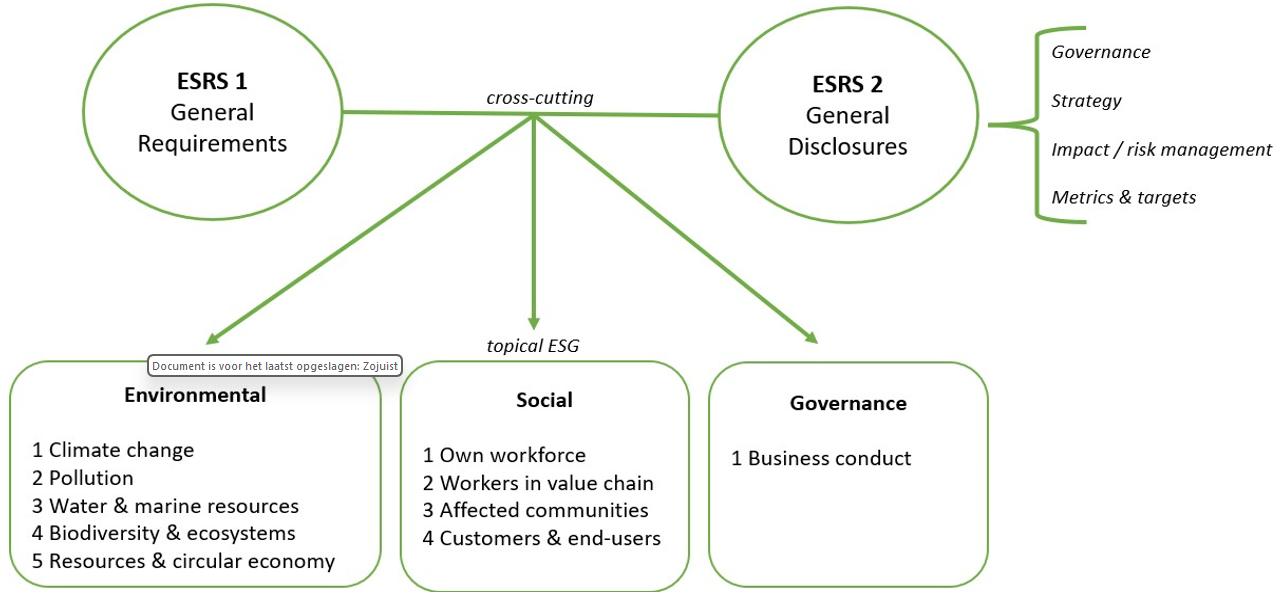What does the first set of ESRS look like?
The first set of ESRS that have been drafted by EFRAG is a set of twelve standards that apply to all undertakings in every sector that fall under the CSRD. These standards are the sector agnostic standards. The European Commission adopted them as the first set of general ESRS standards in July 2023.
The twelve ESRS are divided into:
- two cross-cutting standards (ESRS 1+2) containing the general requirements and general clarifications, which are necessary for the ‘thematic standards’; and
- ten topical standards (E1 to E5, S1 to S4 and G1).
- the 'topical' ESRS contain the disclosure requirements for the ESG topics. Within each of the topics there are disclosure requirements for, inter alia, governance (GOV), strategy and business model (SBM), impact-, risk and opportunity management (IRO) and metrics and targets (MT). The ESRSs use these abbreviations to indicate the different disclosure requirements.
See below a schematic representation of these twelve sector agnostic standards divided into two cross-cutting standards and ten thematic ESG standards.

The final first ESRS set does not need be implemented in national law because this concerns EU delegated legislation. The European Commission adopted the first ESRS set on 31 July 2023 and this set was published on 22 December 2023. See here for the text of the ESRS.
Which cross-cutting standards are there?
There are two cross-cutting ESRS:
- ESRS 1 General requirements
- ESRS 2 General disclosures
These two ‘cross cuttings’ standards form the basis of the sustainability report and contain the 'playbook' and disclosure requirements for the sustainability report of any undertaking. The thematic E, S and G-ESRS contain references to these cross-cutting standards.
Which Environmental ESRS are there?
There are five environmental ESRS:
E1 Climate change
E2 Pollution
E3 Water and marine resources
E4 Biodiversity and ecosystems
E5 Resource use and circular economy.
Each of these environmental standards contains disclosure requirements for, among other things:
- Governance (GOV),
- Strategy and business model (SBM),
- Impact and risk management (IRO) and
- Metrics and targets (MT).
Which Governance ESRS are there?
There is one governance ESRS, Business conduct. The ESRS on business conduct consists of the following disclosure requirements:
G1-1 Corporate culture
G1-2 Procurement management
G1-3 Prevention and detection of corruption/bribery
G1-4 Confirmed incidents of corruption or bribery
G1-5 Engagement to exert political influence and lobbying activities
G1-6 Payment practices.
In addition, the cross-cutting ESRS contain some mandatory disclosure requirements regarding governance which apply to every undertaking.
Which Social ESRS are there?
There are four social ESRS:
S1 Own Workforce
S2 Workers in the value chain
S3 Affected communities
S4 Consumers and end-users.
Each of these environmental standards contains disclosure requirements for, among other things:
- Governance (GOV),
- Strategy and business model (SBM),
- Impact and risk management (IRO) and
- Metrics and targets (MT).


